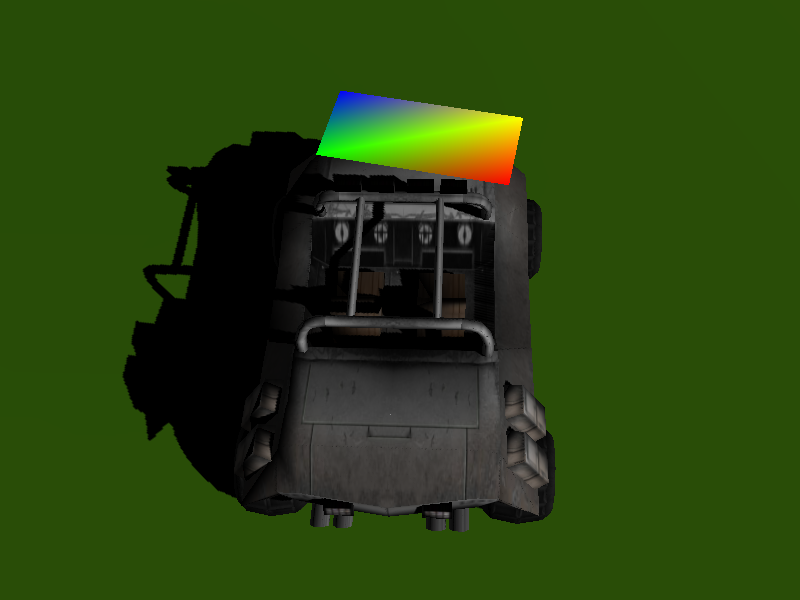Regarding my city generation topic I have a set of small-scale questions regarding Urho3D
and best practices to do things.
The first question is - how can I create Model so I can use several materials with it,
but it should be single model still. I know it is related to Geometry, so Model should contain Geometry for each material.
But I have problems setting-up proper model, as I don’t really understand how to set up VertexBuffer and IndexBuffer for
this configuration, what is actual sequence? I could not find any code sample about this 
I’d be very happy to see AngelScript code sample for this.
What I do to dissect such model:
class DissectModel {
String name;
Model@ model;
Geometry@ geometry;
VertexBuffer@[] buffers;
float[] vertex_data;
uint16[] index_data;
VectorBuffer[] vertexdata;
Array<Vector3> verts;
IndexBuffer@ ib;
uint16[] index;
DissectModel(String fn, int geonum)
{
model = cache.GetResource("Model", fn);
geometry = model.GetGeometry(geonum, 0);
ib = geometry.indexBuffer;
VectorBuffer indexdata = ib.GetData();
for(int i = 0; i < geometry.numVertexBuffers; i++) {
buffers.Push(geometry.vertexBuffers[i]);
vertexdata.Push(geometry.vertexBuffers[i].GetData());
uint num_verts = geometry.vertexBuffers[i].vertexCount;
uint vertex_size = geometry.vertexBuffers[i].vertexSize;
Print("num_verts: " + String(num_verts));
Print("vertexSize: " + String(vertex_size));
if (buffers[i].HasElement(TYPE_VECTOR3, SEM_POSITION))
Print("Has position at " +
String(buffers[i].GetElementOffset(TYPE_VECTOR3, SEM_POSITION)));
else
continue;
if (buffers[i].HasElement(TYPE_VECTOR3, SEM_NORMAL))
Print("Has normal at " +
String(buffers[i].GetElementOffset(TYPE_VECTOR3, SEM_NORMAL)));
else
continue;
if (buffers[i].HasElement(TYPE_VECTOR2, SEM_TEXCOORD))
Print("Has texture coordinate at " +
String(buffers[i].GetElementOffset(TYPE_VECTOR2, SEM_TEXCOORD)));
for (int j = 0; j < num_verts; j++) {
vertexdata[i].Seek(j * vertex_size + buffers[i].GetElementOffset(TYPE_VECTOR3, SEM_POSITION));
verts.Push(vertexdata[i].ReadVector3());
vertexdata[i].Seek(j * vertex_size + buffers[i].GetElementOffset(TYPE_VECTOR3, SEM_NORMAL));
verts.Push(vertexdata[i].ReadVector3());
}
indexdata.Seek(geometry.indexStart * ib.indexSize);
for (int j = 0; j < geometry.indexCount; j++) {
uint16 idx = indexdata.ReadUShort();
Print("Index: " + String(j) + " idx: " + String(idx));
index.Push(idx);
}
}
}
Array<Vector3> get_vertices(Vector3 offt = Vector3())
{
Array<Vector3> ret;
for(int i = 0; i < index.length; i++) {
ret.Push(verts[index[i] * 2] + offt);
}
return ret;
}
}And I use the following code to generate single-geometry model"
mixin class ScratchModel {
float[] vertex_data;
uint16[] index_data;
BoundingBox bbox = BoundingBox(Vector3(0.0, 0.0, 0.0), Vector3(1.0, 1.0, 1.0));
int num_vertices()
{
return vertex_data.length / 6;
}
Model@ model = Model();
void create()
{
for (uint i = 0; i < num_vertices(); i += 3) {
Vector3 v1(vertex_data[6 * i], vertex_data[6 * i + 1], vertex_data[6 * i + 2]);
Vector3 v2(vertex_data[6 * i + 6], vertex_data[6 * i + 7], vertex_data[6 * i + 8]);
Vector3 v3(vertex_data[6 * i + 12], vertex_data[6 * i + 13], vertex_data[6 * i + 14]);
Vector3 edge1 = v1 - v2;
Vector3 edge2 = v1 - v3;
Vector3 normal = edge1.CrossProduct(edge2).Normalized();
vertex_data[6 * i + 3] = vertex_data[6 * i + 9] = vertex_data[6 * i + 15] = normal.x;
vertex_data[6 * i + 4] = vertex_data[6 * i + 10] = vertex_data[6 * i + 16] = normal.y;
vertex_data[6 * i + 5] = vertex_data[6 * i + 11] = vertex_data[6 * i + 17] = normal.z;
}
VertexBuffer@ vb = VertexBuffer();
IndexBuffer@ ib = IndexBuffer();
Geometry@ geom = Geometry();
vb.shadowed = true;
Array<VertexElement> elements;
elements.Push(VertexElement(TYPE_VECTOR3, SEM_POSITION));
elements.Push(VertexElement(TYPE_VECTOR3, SEM_NORMAL));
vb.SetSize(num_vertices(), elements);
VectorBuffer temp;
for (uint i = 0; i < vertex_data.length; ++i)
temp.WriteFloat(vertex_data[i]);
vb.SetData(temp);
ib.shadowed = true;
ib.SetSize(num_vertices(), false);
temp.Clear();
for (uint i = 0; i < num_vertices(); ++i)
temp.WriteUShort(index_data[i]);
ib.SetData(temp);
geom.SetVertexBuffer(0, vb);
geom.SetIndexBuffer(ib);
geom.SetDrawRange(TRIANGLE_LIST, 0, num_vertices());
model.numGeometries = 1;
model.SetGeometry(0, 0, geom);
model.boundingBox = bbox;
}
void add_vertex(Vector3 v)
{
vertex_data.Push(v.x);
vertex_data.Push(v.y);
vertex_data.Push(v.z);
for (int i = 0; i < 3; i++)
vertex_data.Push(0);
uint16 idx = index_data.length;
index_data.Push(idx);
}
}
class Triangle : ScratchModel {
Node@ node = Node();
StaticModel@ object;
float[] vertex_data = {
0, 0, 0, 0, 0, 0,
0, 1, 0, 0, 0, 0,
1, 0, 0, 0, 0, 0,
};
uint16[] index_data = {
0, 1, 2
};
BoundingBox bbox = BoundingBox(Vector3(0.0, 0.0, 0.0), Vector3(1.0, 1.0, 0.0));
Triangle()
{
create();
object = node.CreateComponent("StaticModel");
object.model = model;
}
}So I need to extend it to have multiple Geometry to use multiple materials. I know VertexBuffer and IndexBuffer can be shared with all
geometries (but I don’t understand if it is mandatory, I’m very new to the subject). Any ideas?
Any help will be appreciated.


